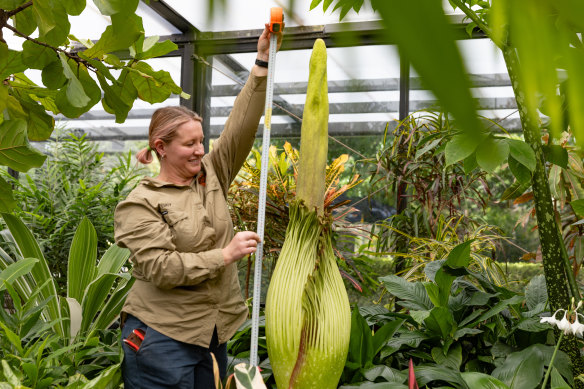Geelong braces for putrid stench of death as corpse flower begins to ...
Geelong’s corpse flower has begun to bloom and will be fully open on Monday afternoon, revealing its putrid “dead possum” stench.

The corpse plant, Amorphophallus titanum, flowers once every seven to 10 years – and then only for 48 hours, before the flower withers and dies.
Geelong’s Botanic Gardens are keeping the doors open for the next 48 hours so as many people as possible can see and smell it.
Those who can’t make it in person can view the plant on a live stream.
It smells like “dead rat, dead possum” mixed with “rotten cheese and fermenting cabbage”, says Matt Coulter, horticultural curator and corpse flower expert at the Botanic Gardens of South Australia, which gifted the immature plant to the Geelong Botanic Gardens several years ago.
The corpse flower has been building up to this moment, stockpiling energy, for a decade.
Lucy Griffiths, nursery horticulturist at Geelong Botanic Gardens, measures the flower last week.Credit: Jason South
The process will happen for two gloriously disgusting days. And then the flower will die, and the plant will retreat underground for another 10 years.
In the wild, corpse plants grow only in tropical Sumatra and Java in Indonesia, where they are endangered by palm oil plantations, poachers and their steadfast refusal to reproduce in a sensible manner.
To spread their pollen, corpse flowers seek not bees but carrion flies and beetles, which typically feed or lay their eggs on rotten flesh. To draw them, the plant engages in mimesis: its smell resembles a dead animal, its flowers are the deep red of congealed blood.
Its scent comes from a suite of volatile molecules, including dimethyl disulfide (garlic), dimethyl trisulfide (rotten flesh), methyl thioacetate (sulfur) and isovaleric acid (cheese or sweat).
Over seven to 10 years, the plant builds an enormous underground root – known as a corm – which looks like a huge sweet potato and can be as heavy as 150 kilograms. Geelong’s corpse flower is young and weighs just 10 kilograms.
This stored energy is then used to produce a huge flower.
The tightly wrapped leaves, or spathe, have opened to reveal hundreds of small flowers at the base of the spadix – the central pillar.
The heat of the spadix drags the scent up from the base and then pushes it out in putrid pulses, attracting any nearby insects to lay their eggs in the rotting “flesh”. The plant can get so hot it starts steaming.
Loading
“The insects are running around, trying to find the best place to lay their eggs, and while they do that they are running around all over the male and female parts of the flowers,” says Geelong Botanic Gardens co-ordinator Kellee Reissinger.
They will leave disappointed – but covered in the plant’s pollen. If this were Sumatra, they would hopefully encounter another corpse flower to spread it.
Many plants can self-pollinate, sharing pollen between male and female flowers on the same plant.
Not the corpse flower: the female flowers are receptive for 24 hours, then it is the male flowers’ turn. If it does not get pollinated, the whole structure then collapses within a week.
Get to the heart of what’s happening with climate change and the environment. Sign up for our fortnightly Environment newsletter.
Loading











































